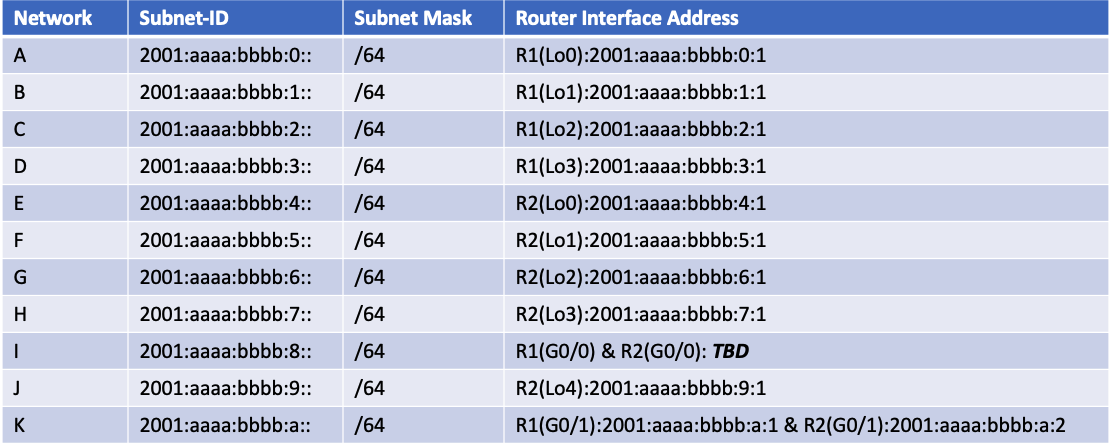

NOTE: Please read the following lab guidelines before working on this lab. - If any device contains preconfigured login credentials use, cisco/cisco - If you plan working on more than one Lab Task during the day (all related to the same course), open the first lab environment and keep it open for subsequent labs (unless instructed otherwise) to save yourself excessive bootup time. Simply read the Lab Objectives from subsequent labs and perform them on your first, opened lab environment.
Solutions:
Task-1 Solution
Starting Network: 2001:aaaa:bbbb::/48

Task-2 Solution
R1(config)#int loopback 0
R1(config-if)#ipv6 address 2001:aaaa:bbbb:0::1/64
R1(config-if)#interface loopback 1
R1(config-if)#ipv6 address 2001:aaaa:bbbb:1::1/64
R1(config-if)#interface loopback 2
R1(config-if)#ipv6 address 2001:aaaa:bbbb:2::1/64
R1(config-if)#interface loopback 3
R1(config-if)#ipv6 address 2001:aaaa:bbbb:3::1/64
R1(config-if)#exitLink-local addresses always begin with FE80:: and utilize an EUI-64 interface-ID (unless otherwise configured). In order to predict what the Link-Local interface-ID would be for Gig0/0 on router R1 you needed to determine the MAC address used on this interface. This could have been discovered using the following command:
R1#show interface gig 0/0
GigabitEthernet0/0 is up, line protocol is up
Hardware is iGbE, address is 02aa.bbfe.ff02 (bia 0c74.0c9f.0000)
[Output Omitted]
Notice in the output above that this interface has two MAC addresses. This is because the burned-in-address (BIA) starting with 0c74 has been manually overridden with the "mac 02aa.bbfe.ff02" command. It is this manually-assigned MAC address that will be used in the dynamic Link-Local address.
See below:
!
interface GigabitEthernet0/0
ipv6 address 2001:AAAA:BBBB:8::/64 eui-64
end
In order for R2 to obtain its IPv6 prefix (via SLAAC) from R1, R2 required the following interface command:
R2(config)#interface gigabitEthernet 0/0
R2(config-if)#ipv6 address autoconfig
R2(config-if)#no shutdownHowever, the command above would not have been enough to meet the objective. R1 needs to be able to transmit IPv6 Router Advertisements so that R2 can learn of the IPv6 global prefix. In other words, R1 needs to recognize that it should function as an IPv6 router (as opposed to an IPv6 host). This requires that R1 be configured with the following command:
Router(config)#ipv6 unicast-routingSee below:
R1(config)#interface gig0/1
R1(config-if)#ipv6 address 2001:aaaa:bbbb:a::1/64
R1(config-if)#no shut
R1(config-if)#endR2(config)#interface gig0/1
R2(config-if)#ipv6 address 2001:aaaa:bbbb:a::2/64
R2(config-if)#no shut
R2(config-if)#endAnswers to questions are below:
Answer:
R1#show ipv6 interface brief | begin Loopback0
Loopback0 [up/up]
FE80::AA:BBFF:FEFE:FF02Answer:
R2#show ipv6 interface brief
GigabitEthernet0/0 [up/up]
FE80::E54:D1FF:FE30:0
2001:AAAA:BBBB:8:E54:D1FF:FE30:0
NOTE: Your interface-ID may be different considering that your MAC address will be different.
Answer:
R1#show ipv6 interface gig0/0
GigabitEthernet0/0 is up, line protocol is up
IPv6 is enabled, link-local address is FE80::AA:BBFF:FEFE:FF02
No Virtual link-local address(es):
Global unicast address(es):
2001:AAAA:BBBB:8:AA:BBFF:FEFE:FF02, subnet is 2001:AAAA:BBBB:8::/64 [EUI]
Joined group address(es):
FF02::1
FF02::2
FF02::1:FFFE:FF02